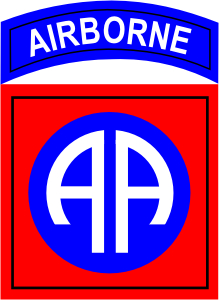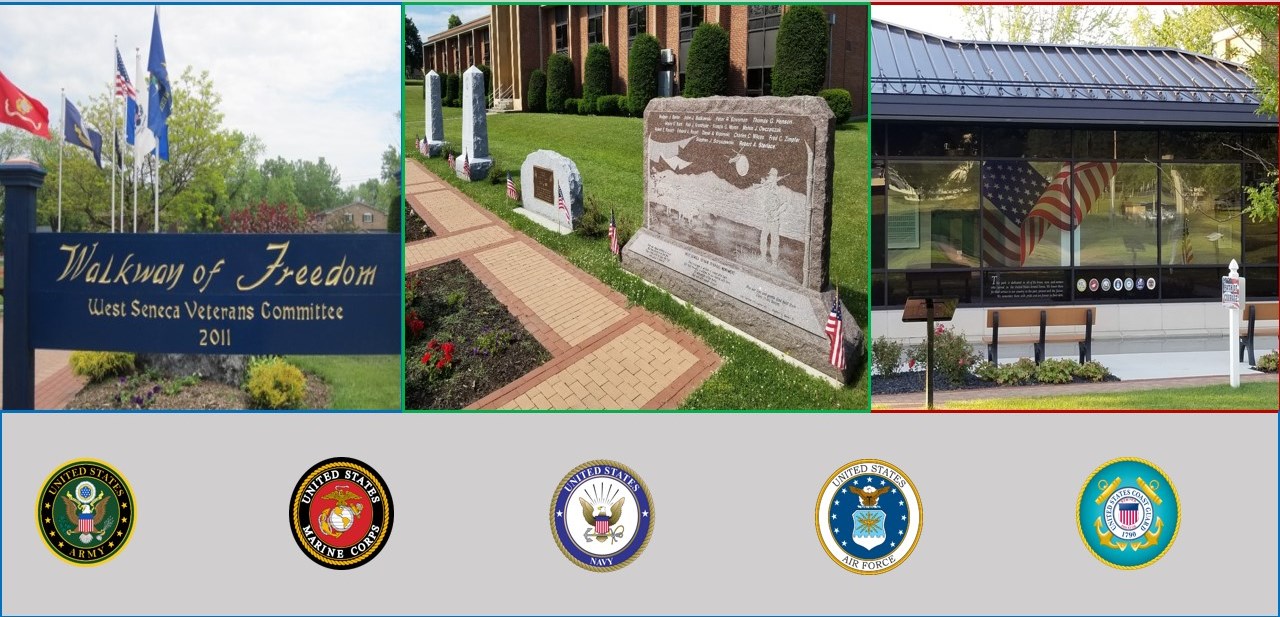
35 Legion Parkway
West Seneca,
New York 14224
U.S.A.

American Legion
Post 735

Marine Corp. League
Detachment 239

Veterans of Foreign Wars
VFW Post 8113

Navy Seabee Veterans
of America, Island X-5

AMVETS
Post 8113

82nd Airborne


West Seneca Joint Veterans Committee |
|
AMERICAN OVERSEAS CEMETERIES
The American Battle Monuments Commission (ABMC), established by the United States Congress in 1923, is an independent agency of the United States government that is responsible to the people of the United States for the construction and permanent maintenance of military cemeteries and memorials built by the United States Government on foreign soil as well as for certain monuments on American soil.
As of 2018, there were 26 cemeteries and 29 memorials, monuments and markers under the care of the ABMC. There are more than 140,000 U.S. servicemen and servicewomen interred at the cemeteries, and more than 94,000 missing in action, or lost or buried at sea are memorialized on cemetery Walls of the Missing and on three memorials in the United States. The American Battle Monuments Commission also maintains an online database of names associated with each site.
At the time of the Armistice on November 11, 1918, there were approximately 2,400 places in Europe in which American dead were temporarily buried. After hostilities ceased, provision was made for the permanent burial of these soldiers in accordance with the expressed wishes of the nearest relatives, and eight American Military Cemeteries in Europe were established. These cemeteries now contain the over 30,910 graves of all members of the American forces whose bodies remain in Europe, save for those few who were buried elsewhere at the request of relatives, and those remains have not been found.
Of the eight cemeteries in Europe, six are in France, one is in Belgium, and one is in England where our honored dead rest in peace. Their government provides for their graves its constant and perpetual care. Each grave is marked by a headstone of white marble, 3 foot 3 inches in height, a Star of David for those of Jewish faith, a Latin Cross for all others.
The headstones were quarried and fabricated in the Italian Tyrol, northwest of Venice, except about one-half of those at the Philippines Cemetery which came from the region of Carrara in western Italy. Each headstone bears the deceased's name, rank, service number, organization, date of death, and state or territory from which he entered the military service. Headstones of the UNKNOWNS, remains which could not be identified, bear the inscription: HERE RESTS IN HONORED GLORY A COMRADE IN ARMS KNOWN BUT TO GOD.
At the end of World War II, several hundred temporary cemeteries had been established. Fourteen sites in foreign countries were selected as permanent cemeteries. In each, a memorial was erected to commemorate the services and sacrifices of the men of the American armed forces who fought in the respective regions.
Headstones are the same design as used for the World War I cemeteries; white marble with the Star of David for the Jewish faith and the Latin Cross for all others. Each headstone bears the deceased's name, rank, service number, organization, date of death, and state or territory from which he entered the military service.
In each cemetery is a memorial chapel, beautiful in design and restful in spirit, where visitors may go for meditation and prayer. A reception room is provided for the convenience of visitors, and an American superintendent is present to give information. On the walls of the memorial in each of the cemeteries are inscribed the names of the MISSING who, in that region gave their lives in the service of their Country, but whose remains were never recovered or identified, including those buried or lost at sea. A small non-denominational chapel forms part of each cemetery memorial. Over each cemetery the United States flag always flies during daylight hours.
On the walls of each chapel are inscribed the names of those American soldiers and sailors who lost their lives in the vicinity and who sleep in unknown graves. The chapel in the Meuse-Argonne cemetery also bears the names of the Services of Supply and of the American expedition to Northern Russia. The names of those American soldiers and sailors who lost their lives at sea appear on the walls of the chapels at Suresnes and Brookwood
The graves in these cemeteries number approximately 39 percent of those originally buried in these regions. The remains of the other 61 percent were returned home at the request of their next of kin.
The United States established shrines to the memory of those forces who died in Europe during World War I and in Europe and the Pacific during World War II. They are dedicated, in grateful remembrance, to the sacrifices of the American Armed Forces who fought around the world. Although constructed on foreign land, each of the American cemeteries are considered American soil.
CEMETERIES AND MEMORIALS, WORLD WAR I
FLANDERS FIELD, Waregem, Belgium BROOKWOOD, England AISNE – MARNE, Belleau, France MEUSE-ARGONNE, Romagne, France OISE-AISNE, Fere, France SOMME, Bony, France ST. MIHIEL, Thiaucourt, France SURESNES, France
BELGIUM
FLANDERS FIELD CEMETERY
Flander Fields, Belgium
Flanders Field Cemetery is located near the village of Waeregheim in that part of Belgium formerly known as Flanders. It is 17 miles southwest of Ghent and 39 miles west of Brussels.
In this cemetery lie 368 Americans lie. Most of them gave their lives when the 37th and 91st U.S. Army Divisions took part in the liberation of western Belgium during the final days of the war in in November 1918. Waereghem and the site where the cemetery is located, were captured by American troops.
The chapel is of white limestone, with bronze doors and a marble altar.
ENGLAND
BROOKWOOD CEMETERY
Brookwood Cemetery, England
Brookwood American Cemetery is 25 miles southwest of London and may be reached conveniently by automobile or train from the capital.
In this cemetery lie 468 Americans who died in Great Britain during 1917 and 1918.
The chapel, of classic design, is built of white stone, with bronze doors; marble columns and a marble altar add beauty to its interior. The whole cemetery is beautifully framed in masses of pine trees.
FRANCE
AISNE-MARNE CEMETERY
Aisne-Marne Cemetery, France
Aisne-Marne Cemetery is laid out in a sweeping curve at the foot of the hill upon which stands Belleau Wood. This is the nearest to Paris of the battlefield cemeteries of World War I and may be reached by a 55-mile drive. Chateau-Thierry is 5 miles distant.
In this cemetery lie 2,288 American dead, most of whom gave their lives in the battles in this region during the summer of 1918. Belleau Wood and the cemetery site were recaptured by American troops.
The chapel is of warm-tinted limestone; its tower affords a view of the cemetery and battlefield.
MEUSE-ARGONNE CEMETERY
Meuse-Argonne Cemetery, France
Meuse-Argonne Cemetery, near Romagne-sous-Mantfaticon, France, is the largest of the American cemeteries of World War I. The nearest city is Verdun, 18 miles away. Paris lies 150 miles, and Reims 56 miles, to the west.
In this cemetery lie 14,243 American dead, most of whom gave their lives during the 48-day Meuse-Aargonne battle which ended on 11 November 1918, with the armistice.
The warm-hued limestone chapel, with its loggias bearing the names of the missing, is proportioned to the size of the cemetery.
OISE-AISNE CEMETERY
Oise-Aisne Cemetery, France
Oise-Aisne Cemetery lies about midway between Chateau-Thierry and Soissons on the battlefield over which American troops fought their way forward during the summer of 1918. It is 58 miles from Paris.
In this cemetery lie 6.012 Americans, most of them gave their lives in combat in this region.
The masonry of the chapel is predominantly pink, its marble colonnade forming a background for an altar of golden limestone. Throughout the summer months long beds of roses add their color to make this one of the most beautiful of our military cemeteries
SOMME CEMETERY
Somme Cemetery, France
Somme Cemetery is situated southwest of the village of Bony, France, which is ¾ miles west of the highway from St. Quentin and 98 miles northeast of Paris.
This cemetery, 14 acres in extent, sited on a gently sloping hill typical of the open, rolling country of this section of France, contains the graves of 1,837 of our military Dead. Most of those lost their lives while serving with the British Armies, or in the operations near Cantigny. The headstones set in regular rows are divided into four plots by wide paths which intersect at the flagpole at the top of the slope. The longer axis leads to the chapel at the eastern end of the cemetery.
On the outer walls of the chapel are sculptured articles of equipment. A massive bronze door surmounted by an American eagle forms it entrance. A cross-shaped window of crystal glass, above the marble altar, shines in illuminated radiance against the subdued interior. On the walls are inscribed the names of 333 of the Missing, whose remains were never recovered or identified.
ST. MIHIEL CEMETERY
St. Mihiel Cemetery, France
The cemetery, 40 ½ acres, contains the graves of 4,152 Americans lost in combat. The majority gave their lives in the great offensive which resulted in the reduction lf the St. Mihiel salient. Headstones are aligned in long rows, divided in 4 plots by wide avenues with tree-bordered walks. At the center is a large sundial surmounted by an American eagle. To the west is a small monument; at the eastern end is an ornamental urn on a semicircular platform.
Beyond the burial area to the south is the white stone memorial consisting of a small chapel, a peristyle with a large rose-granite urn in the center, and a museum The chapel contains a beautiful mosaic portraying an angel sheathing the sword. On the end walls of the museum are recorded the names of 284 of the Missing, whose remains were never recovered or identified; on the wall opposite the door is an inlaid marble map of the St. Mihiel offensive
SURESNES CEMETERY
Surnesnes Cemetery, France
Suresnes Cemetery is located on a wooded hillside below Fort Mont Valerien in the suburb of Suresnes, about 5 miles from the center of Paris. Located high on the slopes of Mont Valerien, a fine panorama os a large part of Paris can be viewed from the site. It can easily be reached by car or train from the capital.
At this cemetery, 7 1/2 acres in extent, rest 24 of our unknown Dead of World War II, together with 1,541 Americans who died in World War I. Inscribed on the walls of the chapel are the names of 974 of the Missing, who are buried or lost at sea in 1917 and 1918. dead, has on many occasions been the site of impressive memorial ceremonies in which both French and American government representatives have paid their official homage to our dead.
Originally a World War I cemetery, Suresnes now shelters the remains of our Dead of both wars. The World War I memorial chapel has been modified, and enlarged by the addition of two loggias dedicated to the Dead of World War I and of World War II, respectively. In the rooms at the end of the loggias are white marble figures of "Memory" and "Remembrance" of those who gave their lives in these two wars. Inscribed on the walls of the loggias is a summary of the loss of life in our Armed Forces in each war, together with the location of all the overseas cemeteries where our Dead are buried. Senior representatives of the American and French Governments assemble on ceremonial occasions at Suresnes cemetery to honor the memory of our military Dead.
AUDENARDE MONUMENT
Audenarde Monument is located in the town of Audenarde, Belgium, 17 miles south of Ghent, 37 miles west of Brussels and 164 miles north of Paris.
The monument, of golden-yellow limestone bearing the shield of the United States flanked by two stone eagles, stands at the end of a small park which provides its setting and which is maintained by the United States Government. It commermorates the services of the 40,000 American troops, who in October and November 1918, fought in the vicinity as units attached to the Group of Armies commanded by the King of the Belgiums. Many of them are buried in the Flanders Field Cemetery near Waregem, 7 miles to the west.
KEMMEL MONUMENT
Kemmel Monument is 4 miles south of Ypres (Ieper), Belgium, near the hamlet of Vierstraat, on the Mont Kemmel road, overlooking a wide stretch of the long and bitterly contested Ypres battlefield. Ypres is 30 miles south of Ostend, 74 miles west of Brussels and 157 miles north of Paris.
This monument consists of a rectangular white stone block, in front which is carved a soldier's helmet resting upon a wreath. It commemorates the services of those American troops who, in the summer of 1918, fought in this area as units attached to the British Army: some of these Dead rest in the Flanders Field Cemetery near Waregem, 34 miles to the east.
BELLICOURT MONUMENT
Bellicourt Monument is 9 miles north of St. Quentin, Aisne, France, on the highway to Cambrai and 1 mile north of the village of Bellicourt; it is 97 miles northeast of Paris. Erected above a canal tunnel built by Napoleon I, this monument commemorates the achievements of the 90,000 American troops who served in battle with the British Armies in France during 1917 and 1918.
The tunnel was one of the main defense features of the Hindenburg Line which was broken by American troops in a brilliant offensive in September 1918. Behind the sculptured main feature of the memorial is a carved map illustrating the American operations; on the terrace is a circular orientation table.
CANTIGNY MONUMENT
Cantigny Monument is is the village of Cantigny, Somme, France, 4 miles northwest of Montdidier and 66 miles north of Paris.
This battlefield monument, commemorating the first offensive operation, in May 1918, by a large American unit in World War I, stands in the center of the village which was captured in that attack and which was completely destroyed by artillery fire. It consists of a white stone shaft, on a platform, surrounded by an attractive park developed and maintained by the United States Government. The quiet surroundings now give no hint to the bitter hand-to-hand fighting which took place near the site of the monument.
AISNE-MARNE MONUMENT
Aisne-Marne Memorial is on a hill 2 miles west of Chateau-Thierry and commands a sweeping view of the valley of the Marne. It is 54 miles east of Paris, 4 1/2 miles east of the Aisne-Marne (Belleau) Cemetery and 17 miles southwest of the Oise-Arne (Fere) Cemetery where rest many of the American soldiers and marines who fought in this region in the summer of 1918. Two stone pylons mark the entrance from the Paris-Chateau-Thierry highway.
The monument consists of an impressive double colonnade rising above a long terrace; on its west facade are heroic sculptured figures representing the United States and France. On the east facade is a decorative map of American military operations in this region.
BELLEAU WOOD MONUMENT
Belleau Wood, due south of the Aisne-Marne Cemetery and adjoining it, is maintained as a memorial to all American soldiers who fought in World War I. Vestiges of trenches, shell holes and many relics of the war, including weapons found in the vicinity still exist.
In the center of the wood, a collection of World War I cannon is grouped around a flagstaff on an island in the road. In front is a monument consisting of a black granite slab with a life-size bas-relief commemorating the valor of the U. S. Marines who captured this ground in 1918.
BLANC MONT MONUMENT
Blanc Mont Monument is 3 miles northwest of SommePy, Marne, France. The monument site is 11 miles north of Suippes and 126 miles east of Paris.
The monument, surrounded by vestiges of World War I trenches, dugouts and gun emplacemnts, is essentially a tower, of golden-yellow limestone; the platforms at the top affords a wide view over the former battlefields. The tower is open only on Sunday. Inside the entrance door an inscription relates the American operations in this vicinity. The monument, whose site was captured by American troops in particulaly hard fighting, commemorates the achievements of the 70,000 Americans who served in this region during the summer and fall of 1918.
MEUSE-ARGONNE MONUMENT
Meuse-Argonne Memorial is at Montfaucon, Meuse, France, 6 miles south of the Romagne Cemetery and 19 miles northwest of Verdun. Its massive Doric column is surmounted by a statue symbolic of Liberty, which towers more than 200 feet above the war-torn ruins of the former village. It commerates the Meuse-Argonne offensive in which, during 47 days of fighting between 26 September 1918 and 11 November 1918, the American First Army forced a general retreat on this front.
Inside the entrance door is a foyer on the walls of which are an engraved map of the operations with description; and a tribute to the troops who served here. The observation platform affords magnificent views of the battlefield.
ST.MIHIEL MEMORIAL
St. Mihiel Memorial is situated on the isolated hill of Montsec, France, 12 miles southwest of the St. Mihiel Cemetery, 10 miles east of the town of St. Mihiel.<.p>
This majestic monument, commemorating the achievements and sacrifices of American soldiers who fought in this region in 1917 and 1918, dominates the landscape for miles around. It sonsists of alarge circular colonnade with a broad approach stairway; its central feature is a large bronze relief map of the St. Mihiel salient illustrating the military operations which took place there. The monument was slightly damaged during World War II, but has been completely restored.
SERVICES OF SUPPLY MEMORIAL
The Services of Supply Memorial is located in the city of Tours, France, 146 miles soutwest of Paris.
The monument commemorates the efforts of the 650,000 men who served during World War I in the Services of Supply of the American Expeditionary Forces and whose work behind the battle lines made possible the brilliant achievements of the American armies in the field. The memorial consists of a handsome fourntain of outstanding beauty, with appropriate sculpture, and was built just east of the southern end of the Pont Wilson which crosses the Loire in prolongation of the main street of Tours. The surrounding area was developed by the United States Governement into a small part.
NAVAL MEMORIAL AT BREST, FRANCE
This memorial was erected on the ramparts of the city overlooking the harbor which was a major base of operations for American naval vessels during World War I. The original monument, built on this site, commemorating the achievements of the United Staes Navy during World War I, was destroyed by the enemy on Jyly 4, 1941, prior to American entry into World War II. The present structure is a replica of the original and was completed in 1958.
The monument is a rectangular rose-granite shaft, rising 145 feet above the lower terrace and 100 feet above the Cours d'Ajot. All four sides are ornamented by sculpture of nautical interest. The surrounding area has been developed by the United States Government into an attractive park.
NAVAL MEMORIAL AT GIBRALTOR
At the gateway to the Mediterranean, the memorial consists of a masonryarchway bearing bronze seals of the United States and the Navy Department. This monument, constructed from stone from the neighboring "Rock", commemorates the achievements and sacrifices of the United States Navy in nearby waters and its comradeship with the Royal Navy during World War I.
From this memorial, located in the midst of historic surroundings, a flight of stairs connects the extensive British naval establishments below with the picturesque town above.
CEMETERIES, WORLD WAR II
LOCATION DEAD UNKNOWN MISSING ARDENNES,
Neuville, Belgium5,250 744 465 HENRI-CHAPELLE,
Belgium7,989 89 451 CAMBRIDGE,
England3,811 24 5,125 AISNE – BRITTANY,
St. James, France4,410 95 498 EPINAL,
France5,255 69 424 LORRAINE,
St. Avold, France10,489 151 444 NORMANDY,
St. Laurent, France9,386 307 1,557 RHONE,
Draguignan, France861 62 293 NETHERLANDS,
Margraten, Holland8,301 105 1,722 FLORENCE,
Italy4,402 212 1,409 SICILY-ROME,
Nettuno, Italy7,860 488 3,095 LUXEMBOURG,
Hamm, Luxembourg5,076 101 372 MANILA,
Philippines17,178 3,744 36,269 NORTH AFRICA,
Carthage, Tunisia2,840 240 3,725
BELGIUM
ARDENNES CEMETERY
Ardennes Cemetery, Belgium
Ardennes Cemetery is located near the southeast edge of the village of Neuville-en-Condroz, 12 miles southwest of Liege, Belgium. The main highway to Dinant and Paris passes the entrance. Liege can be reached by train from Paris, Brussels and Germany via Aachen.
The cemetery, 50 ½ acres in extent, contain the graves of 5,250 of our military Dead, many of whom died in the “Battle of the Bulge”. Their headstones are aligned in straight rows which take the form of a huge Greek cross in a lawn and framed by masses of trees.
Nearer the entrance, to the south of the burial area, is the memorial, a rectangular gray stone structure containing a small chapel, three large battle maps of inlaid marble, 24 panels depicting combat and supply activities, and other ornamental features including the insignia of the major United States units in NortheaSt Europe. Two of the maps depict operations of the American Armed Forces, the third commemorates the Services of Supply in the European Theater. On the exterior is some large-scale sculpture. Along the sides, inscribed in granite slabs, are the names of 462 of the Missing who gave their lives in the service of their Country, but who remains were never recovered or identified.
HENRI-CHAPELLE CEMETERY
Henri-Chapelle Cemetery, Belgium
Henri-Chapelle Cemetery is located 2 miles northwest of the village of Henri-Chapelle, which is on the main highway 18 miles from Liege, Belgium and 10 miles from Aachen, Germany. Liege can be reached by train from Brussels and from Germany, via Aachen.
At this cemetery, covering 57 acres, rest 7,989 of our military Dead, most of who gave their lives during the advance of the U. S. Armed Forces into Germany. Their headstones are arranged in gentle arcs sweeping across a broad green lawn sloping gently downhill.
The highway pases through the reservation. To the east is the long colonnade which, with the chapel and museum room, form the memorial overlooking the burial area. The two maps of the military operations, carved on black granite, with inscriptions recalling the achievements of the U. S. Armed Forces.
On pylons of the colonnade are inscribed the names of 450 of the Missing who gave their lives in the service of their Country, but whose remains were never recovered or identified. On the pylons are also carved the seals of the States and Territories.
Across the highway is an overlook that affords an excellent view of the rolling Belgium countryside, once a battlefield.
ENGLAND
CAMBRIDGE CEMETERY
Cambridge Cemetery, England
Cambridge Cemetery is situated 3 miles west of the university city of Cambridge, England, on the main road to the town of St. Neots, and 60 miles north of London.
This cemetery site, 30 ½ acres in extent, was donated by the University of Cambridge. It lies on the north slope of a hill, the west and south sides of the area being framed by woodland. The cemetery contains the graves of 3,811 of our military Dead; on the great wall of the Missing are recorded the names of those remains were never recovered or identified. Most of these died in the Battle of the Atlantic or in the strategic air bombardment of Northwest Europe.
From the flagpole platform, near the main entrance, the great wall, with its reflecting pools, stretches eastward; it is from this mall that the wide, sweeping curve of the burial area across the green lawns is best appreciated. Along the south side is the wall of the Missing; at the far end is the memorial with its chapel, its two huge military maps and its beautiful stained glass windows bearing the State Seals and military decorations.
FRANCE
BRITTANY CEMETERY
Brittany Cemetery, France
Brittany Cemetery lies 1 mile southeast of the village of St. James, Manche, France, 12 miles south of Avranches and 14 miles north of Fougeres. Paris is located 201 miles from St. James.
At this cemetery covering 28 acres in rolling farm country rest 4,410 of our Dead, most of whom gave their lives in the campaigns of Normandy and Northern France. Along the curved retaining wall of the memorial terrace are inscribed the names of 498 of the Missing whose resting place “is known only to God”.
The gray granite memorial, containing the chapel as well as two large operations maps and flags of our military services, overlooks the burial area. Interesting stained glass and sculpture aid in embellishing the structure. The lookout platform of the tower affords an impressive view of the stately pattern of the headstones, as well of the peaceful countryside.
EPINAL CEMETERY
Epinal Cemetery, France
Epinal Cemetery is located 4 miles south of Epinal, Vosges, France on the west bank of the Moselle River. The main highway from Nancy passes the entrance. The cemetery, which is 231 miles east of Paris, can be reached by automobile via Void-Neufchateau-Epinal.
The cemetery, 48 acres in extent, sited on a plateau 100 feet above the river, in the foothills of the Vosges Mountains, contains the graves of 5,255 of our military Dead, most of whom gave their lives in the campaigns across northeastern France to the Rhine and Germany.
The memorial, a rectangular structure with two large bas-relief panels, consists of a chapel, portico, and museum room with its large mosaic map. On the walls of the Court of Honor, which surround the memorial, are inscribed the names of 424 of the missing who gave their lives in the service of their Country and who sleep in unknown graves.
Stretching northward is a wide tree-flanked mall which separates the two large burial plots. At the Northern end of the mall the circular flagpole plaza forms an overlook affording a view of a wide sweep of the Moselle valley.
LORRAINE CEMETERY
Lorraine Cemetery, France
Lorraine Cemetery is situated ¾ mile north of the town of St. Avold, Moselle, France. St. Avold is 28 miles east of Metz and 17 miles southwest of Saarbrucken, and can be reached in about 6 hours from Paris.
The cemetery, which covers 113 ½ acres, contains the largest number of graves of our military Dead of World War II in Europe, a total of 10,489 graves. Most of these lost their lives while fighting in this region. Their headstones are arranged in nine plots in a generally elliptical design extending over the beautiful rolling terrain of eastern Lorraine and culminating in a prominent overlook feature.
The memorial, containing maps in ceramic and service flags, as well as the chapel with five sculptured figures above the altar, stands on a plateau to the west of the burial area. High on its exterior wall is the large figure of St. Avold, the martyred Roman soldier, who overlooks the silent host. On each side of the memorial, and parallel to its front, stretch the walls of the Missing on which are inscribed the names of 444 Americans who gave their lives in the service of their Country but whose remains were never recovered or identified.
NORMANDY CEMETERY
Normandy Cemetery, France
Normandy Cemetery is located on a cliff overlooking Omaha Beach and the English Channel, northeast of St. Laurent-sur-Mer, 10 miles west of Bayeux, Calvados, France. The cemetery is 170 miles from Paris and about 4 hours away from Le Havre.
The cemetery side, at the north end of its ½ mile access road, covers 172 ½ acres and contains the graves of 9,386 of our American Dead. On the walls of the semicircular garden on the east side of the memorial are inscribed the names of 1,557 of our Missing who gave their lives in the service of their Country, and who sleep in unknown graves.
The memorial consists of a semicircular colonnade with a loggia at each end containing four large maps of the military operations. Two orientation tables, which overlook the beach, depict the landings in Normandy and the artificial harbor established there. Standing at the memorial and facing west, one sees in the foreground the reflecting pool, beyond is the burial area with the circular chapel and, at the far end, the large statues representing the United States and France.
RHONE CEMETERY
Rhone Cemetery, France
Rhone Cemetery is in the city of Draguignan, Var, France, 28 miles west of Cannes and 16 miles inland from the coast.
At this cemetery, 12 acres in extent, at the foot of a hill clad with the characteristic cypresses, olive trees, and oleanders of southern France, rest 861 of our military Dead, most of who gave their lives in the liberation of southern France in August 1944. Among the trees, the headstones are arranged in straight lines, divided into four plots, grouped about an oval pool.
On the hillside, overlooking the cemetery, is the chapel with its wealth of decorative mosaic and large sculptured figures. Between the chapel and the burial area the great bronze relief map recalls the military operations in the region. On the retaining wall of the terrace are inscribed the names lf 293 of the Missing who gave their lives in the service of their Country and who sleep in unknown graves.
HOLLAND
NETHERLANDS CEMETERY
Netherlands Cemetery, Holland
Netherlands Cemetery is the only American military cemetery in the Netherlands, lies in the village of Margraten, 6 miles east of Maastrict, on the main highway to Aachen, Germany, 14 miles away. Maastricht can be reached by train from Brussels, Paris, any city in Holland, or from Germany via Aachen.
The tall chapel tower can be seen before reaching the site which covers 65 ½ acres. Within the cemetery entrance the visitor is led to the Court of Honor with its pool reflecting the tower. To the right and left, respectfully, are the visitors’ building, and the museum containing three large, engraved maps depicting the military operations of the American Armed Forces.
Stretching along each side of the Court are the two walls of the Missing on which are recorded the names of 1,722 who gave their lives in the service of their Country, but who sleep in unknown graves. Beyond the chapel is the burial area, divided into 16 plots, where rest 8,301 of our military Dead, their headstones set in long graceful curves. A wide tree-flanked mall leads to the flagstaff which crowns the crest.
The light fixture in the chapel, and the altar candelabra and flowerbowl, were presented by the government of the Netherlands and by the local Provincial administration
ITALY
FLORENCE CEMETERY
Florence Cemetery, Italy
Florence Cemetery is located on the west side of Via Cassia, the main highway connecting Florence, Italy, with Siena and Rome, about 7 ½ miles south of Florence.
The side covers 70 acres, chiefly on the west side of the Greve “torrente”. The wooded hills framing its west limit rise several hundred feet. Stretching upward from the stream in symmetrical curved rows are the headstones of 4,402 of our military Dead.
Above, on the topmost of three broad terraces, stands the memorial marked by a tall pylon surmounted by a large sculptured figure. The memorial has two open atria, or courts, joined by the wall of the Missing upon which are inscribed the names of 1,409 who gave their lives in the service of their Country and who sleep in unknown graves.
The atrium at the south end of the wall of the missing serves as forecourt to the chapel which is decorated with polished marble and mosaic. The north atrium contains the marble operations maps recording the achievements of the American Armed Forces in this region.
SICILY-ROME CEMETERY
Sicily-Rome Cemetery, Italy
Sicily-Rome Cemetery lies at the north edge of the town of Nettuno, Italy, which is immediately east of Anzio, 32 miles south of Rome. The cemetery can be reached by automobile from Rome along the Via Appia Nuova to Anzio, Nettuno, and the cemetery.
The cemetery site covers 77 acres, rising in a gentle slope from a broad pool with an island and cenotaph (empty tomb), flanked by groups of Italian cypress trees. Beyond the pool is the immense field of headstones of 7,862 of our military Dead arranged in gentle arcs which sweep across the broad green lawns beneath rows of Roman pines. The majority of these men died in the operations preceding the liberation of Rome.
At the head of the wide central mall stands the memorial, a building rich in works of art and architecture expressing America’s remembrance of the Dead. It consists of a chapel to the south, a peristyle and a museum room to the north. On the white marble walls of the chapel are engraved the names of 3,094 of the Missing, whose remains were never recovered or identified. The museum contains a bronze relief map and four fresco maps depicting the military operations in Sicily and Italy. At each end of the memorial are ornamental Italian gardens.
LUXEMBOURG
LUXEMBOURGH CEMETERY
Luxembourgh Cemetery, Luxembourgh
Luxembourg Cemetery lies within the city limits of Luxembourg, 3 miles east of the center of the capital which can be reached by train from Paris. It is approximately 6 hours by train from Liege, Belgium and from Germany.
The cemetery, 50 ½ acres in extent, is situated in a beautiful wooded area. Not far from the entrance stands the white stone chapel, set on a wide circular platform surrounded by woods. It is embellished with sculpture in bronze and stone, a stained-glass window with American unit insignia and a mosaic ceiling. Flanking the chapel at a lower level are two large stone pylons upon which are maps carved in various granites with inscriptions recalling the achievements of the American Armed Forces in this region. On the same pylons are inscribed the names of 370 of the Missing who gave their lives in the service of their Country, but who remains were never recovered or identified.
Sloping gently downhill from the memorial is the burial area containing 5,076 of our military Dead, many iof whom gave their lives in the “Battle of the Bulge” and in advance to the Rhine. Their headstones follow along graceful curves; trees, fountains and beds of roses, along the main paths add to the dignity of the ensemble.
PHILIPPINES
MANILA CEMETERY
Manila Cemetery, Philippines
Manila Cemetery is situated southeast of the city of Manila, Republic of the Philippines, within the limits of the former U.S. Army reservation of Fort William McKinley.
The cemetery, 152 acres in extent, is on a prominent plateau, visible at a distance from the east, south, and the west. It contains the largest number of graves of our military Dead of World War II, a total of 17,182, most of whom gave their lives in the operations in New Guinea and the Philippines. The headstones are aligned in 11 plots forming a generally circular pattern, set among the masses of a wide variety of tropical trees and shrubbery.
The chapel, a tall building, enriched with sculpture and mosaic stands near the center of the cemetery. In front of it on a wide terrace are two huge hemicycles with large rooms at each end. Large concrete mosaic maps in these rooms recall the achievements of American Armed Forces in the Pacific, in China, India, and in Burma. On the pylons of the hemicycles are inscribed the names of 36,279 of the Missing who gave their lives in the service of their Country and who sleep in unknown graves.
From the memorial and from other points in the cemetery there are impressive views over the lowlands to Laguna de Bay and toward the distant mountains.
TUNISIA
NORTH AFRICA CEMETERY
North Africa Cemetery, Tunisia
The North Africa Cemetery is located in close proximity to the site of the ancient city of Carthage, Tunisia, destroyed by the Romans in 146 B.C., and lies over part of the site of Roman Carthage. It is near the present town of the same name, 10 miles from the city of Tunis.
At this cemetery, 27 acres in extent, rest 2,840 of our military Dead, heir headstones set in straight lines subdivided into 9 rectangular plots by wide paths, with decorative pools at their intersections. Along the southeast edge of the burial area is the long wall of the Missing, bordering the tree-lined terrace leading to the memorial. On the wall are engraved the names of 3,724 of the Missing who gave their lives in the service of their country, but who remains were never recovered or identified. The chapel and the memorial court with its large map of mosaic and ceramic depicting the operations and supply activities of American Armed Forces across Africa to the Persian Gulf were designed to harmonize with local architecture. The chapel is decorated with polished marble, flags, and sculpture.
Information adapted from: American Overseas Military Cemeteries and Memorials, 1959, American Battle Monuments Commission; American Cemeteries, American Battle Monuments Commission; Epinal American Cemetery and Memorial, American Battle Monuments Commission, 1957
 | Please direct questions or comments to the Webmaster |  |
Copyright 2012 West Seneca Veterans Committee, West Seneca, New York U.S.A. All rights Reserved.





















